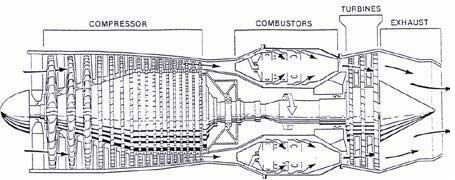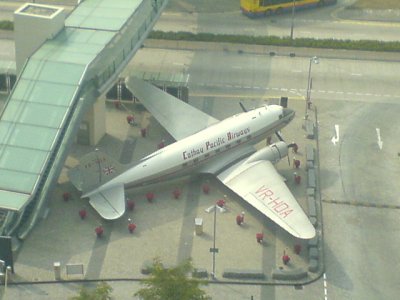|
|
飛機引擎的學問(Notes on Engines)
1. 活塞式引擎如何運作?(How do piston engines work?)
目前差唔多所有汽車同小型飛機都係利用四衝程燃燒循環既原理,
將汽油轉化為動力。呢個四衝程燃燒循環係一八六七年發明,由以
下四組衝程組成:
Almost all cars and light aircraft currently use what is called a four -stroke combustion cycle
to convert gasoline into motion. The four-stroke approach was invented in 1867 and is
comprised of:
– 進氣衝程:當活塞向下移,衝程就開始。呢個時候進氣閥打開,汽
油混合劑流入,排氣閥關閉。
- Intake stroke : The stroke commences with the piston moving downward. The inlet valve
open carrying the petrol mixture with it, the exhaust valve closed.
– 壓縮衝程:當活塞向上移返回原來既位置,衝程將氣體壓縮至活
塞上既空間。燃料經壓縮後,令引擎既功率大大提升,輸出能
量。當火花熄滅既時候,衝程亦都完結。
- Compression stroke: The stroke commences with the piston moving back up to compress
the gases into the space above the piston. The compression of the fuel produces an
immense increase in the efficiency of an engine contributing to power output. The stroke
ends with the passing of the spark.
– 燃燒衝程:兩道閥門保持關閉,內燃室既氣體同火花相遇後迅
速燃燒,所產生既熱力令氣體產生強大壓力,迫使活塞下降至
原來位置。
- Combustion stroke: Both valves remained closed. The gas in the combustion chamber
being ignited by the spark burns rapidly. The heat generated causes the gases to exert a
high pressure on the piston that forces it to descend to its original position.
– 排氣衝程:排氣閥打開後,排氣衝程展開。上升既活塞迫使經
燃燒既氣體同廢氣從油缸經排氣口排出。呢個衝程係上死點結束
,燃燒循環亦都完結。
- Exhaust stroke: The exhaust stroke begins with the opening of the exhaust valve. The
ascending piston forces the burnt or exhaust gases out of the cylinder through the exhaust
port. This stroke, which ends at TDC, completes the cycle.
(四衝程燃燒循環)(Four-stroke Cycle)
(見圖1)

A
進氣閥打開(Intake open)
進氣衝程(Intake Stroke)
B
閥門關閉(Valves closed)
壓縮衝程(Compression Stroke)
C
閥門關閉(Valves closed)
動力衝程(Power Stroke)
D
排氣閥打開(Exhaust open)
排氣衝程(Exhaust Stroke)
2. 渦輪式引擎如何運作?(How do turbine engines work?)
燃氣渦輪式引擎由三部分組成:
Gas turbine engines have three parts:
– 壓縮器:將輸入既空氣壓縮為高壓
- Compressor: Compresses the incoming air to high pressure
– 燃燒區:將燃料燃燒產生高壓同高速氣體
- Combustion area: Burns the fuel and produces high-pressure, high-velocity gas
– 渦輪:從內燃室流出既高壓同高速氣體中抽取能量
- Turbine: Extracts the energy from the high-pressure, high-velocity gas flowing from the
combustion chamber
(操作循環)(The Working Cycle)
(見圖2)

壓縮器(Compressor)
燃燒區(Combustors)
渦輪(Turbines)
排氣口(Exhaust)
3. 渦輪引擎與活塞引擎的比較:
– 同活塞引擎比較, 燃氣渦輪引擎既功率重量比率好巨大, 換言
之,引擎輸出既功率同引擎本身重量既比例相當理想。
- Gas turbine engines have a great power-to-weight ratio compared to piston engines. That
is, the amount of power you get out of the engine compared to the weight of the engine
itself is very good.
– 燃氣渦輪引擎既體積較同等功率既活塞引擎細。
- Gas turbine engines are smaller than their counterparts of the same power.
– 燃氣渦輪需要係高溫下操作,所以佢既設計同製造過程涉及既工程同
材料比較複雜。
- Gas turbines operate at high temperatures, making designing and manufacturing gas
turbines a tough problem from both the engineering and materials standpoint.
– 燃氣渦輪引擎較同樣大小既活塞引擎貴,係空轉狀態時所消耗
既燃料亦比較多。
- Gas turbine engines are also more expensive compared to a reciprocating engine of the
same size and tend to use more fuel when they are idle.
4. 渦輪引擎與活塞引擎的分別:(Differences between turbine/piston engines:)
– 渦輪引擎既空氣壓縮度比較高,所以性能亦都比較好,尤其係較高既飛行
高度。
- Turbine engines have a higher compressibility of air and hence better performance. This
is especially true at high altitude.
(所以飛機飛得愈高消耗既油量亦都會愈小)
(So the airplane flies more high depletion oil's measuring also will be more small)
– 渦輪引擎可藉住唔同既型式產生推力,例如渦輪噴射式引擎、渦輪
扇葉式引擎同渦輪螺旋槳式引擎等等。活塞引擎則只能夠靠螺旋槳產生
推力。
- Turbine engines have different variations to produce the thrust, for example turbo-jet,
turbo-fan and turbo-prop. Piston engines, however, can only rely on the propellers to
produce the thrust.
5. 渦輪引擎的不同型式:(Variations of turbine engines:)
– 渦輪噴射式引擎:由壓縮器、內燃室同渦輪組成,透過將相對較
少量既空氣既速度提升, 藉高速產生推動飛機所需既反作用動力。
- Turbo-jet engines: Consist of a compressor, combustion and turbine section. They
function by accelerating a relatively small amount of air to very high speeds to produce
the reactive force required to move the aircraft.
– 渦輪扇葉式引擎:即係渦輪噴射式引擎既前端安裝扇葉,所以
渦輪最後階段既運作會驅動一條管軸,將動力回傳返去引擎前端,
推動扇葉。
- Turbo- fan engines: They are turbo-jet engines with a large fan in front. The final turbine
stage therefore drives a shaft that makes its way back to the front of the engine to power
the fan.
– 渦輪螺旋槳引擎:渦輪螺旋槳引擎同渦輪扇葉式引擎相類似,只
係引擎既前端以傳統既螺旋槳代替扇葉。
- Turbo-prop engines: Turbo-prop engines are similar to turbo-fan but instead have a
conventional propeller at the front of the engine.
加送一張係國泰城門前既飛機
呢架係國泰航空公司既第二架飛機既Copy
國泰既第一架飛機係科學館內

|
|

